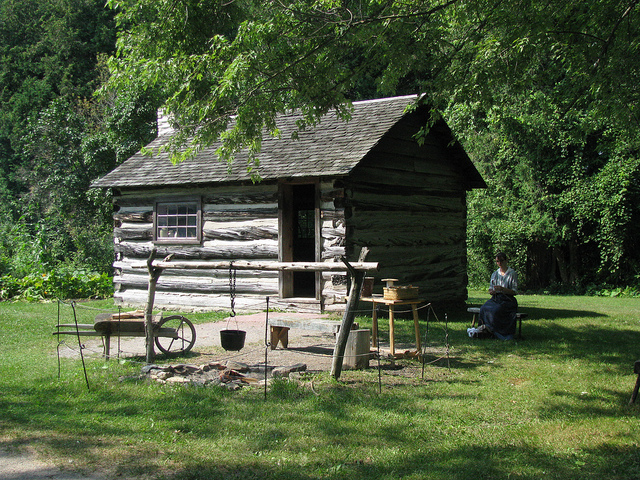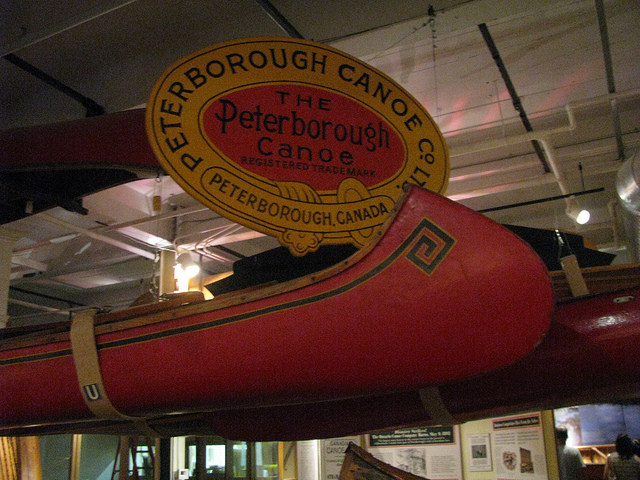Steps away we stopped at the Blacksmith Shop, which was built in 1859, where we connected with John Hodson again. John is also trained as a blacksmith. He was just operating the state-of-the-art double-action bellows to stoke the fire when we entered and demonstrated the making of a miniature horseshoe, one of the 600 horseshoes that he has already produced for the gift shop this year. With his skilled hands he easily shaped the hot metal and had to reheat it once to finish his work. That’s where the expression “strike while the iron is hot” comes from.

John Hodson shows us how he makes a miniature horseshoe
At the northern end of the Lang Pioneer Village is the Glen Alda Church, a simple unadorned Methodist church that was built in 1898 and brought here from the village of Glen Alda. Here Julia explained some of the social paramaters of pioneer life. Churches were extremely important to early settlers. A division of labour between men and women dictated that men would plough the fields, tend the horses, do the planting and take the grain to the mill. Women would take care of the house and garden, the washing and spinning. Girls would make soap and candles from animal fat and men would handle the weaving during the winter.

The historic Glen Alda Church at the Lang Pioneer Village
Winter was generally an less arduous time with less work responsibilities on the field and an easier way to travel by sleigh over frozen lakes. Marriages would also usually take place during the less busy winter months. Julia explained that pioneer life was all about work and not about leisure. Even young children had to pitch in wherever they could.

Interior of the David Fife cabin
Life on a pioneer farm was also quite solitary, where the closest neighbour might often be 20 miles away. Settlers would be given a plot of land and would have to clear it from trees and rocks. Their initial settlement would usually have been a simple shack or lean-to. The next stage would be a small cabin which is illustrated by the Fife Cabin which was built in 1825. David Fife came to Canada as a young man from Scotland and lived in this small cabin with his wife and their three young children. He is also renowned for introducing Red Fife wheat to Canada, a hardy wheat variety that his family started to grow in 1842.

The Fitzpatrick House illustrates the second stage of pioneer settlement during the 1840s
Across the street is the Fitzpatrick House which represents a settler’s second home and was built in the 1840s. This house is already much more elaborate than the Fife Cabin and has a fairly spacious kitchen, a bedroom and a parlour on the main floor. Meals were cooked in the hearth over the open fire, even cookies were baked in this manner, and a simple metal rotisserie would roast the meat. The historical interpreter in this house showed us a variety of heritage vegetables that would have been grown by the settlers: pumpkins, applies, squash, potatoes, tomatoes and corn, as well as a variety of herbs that would be dried for use during the winter.

Heirloom vegetables at the Fitzpatrick House
She also showed us a yoke that was used by children for carrying two pales of water, since the house had no running water and no plumbing. The upstairs of the Fitzpatrick House has a main room with several spinning wheels, as well as a trundle bed that was shared by six girls. Three boys shared a bedroom while grandmother had her own room on the second floor. While the Fitzpatrick house is much more elaborate than the Fife Cabin, it illustrates that the life of the early settlers offered no luxuries.

Audrey Caryi showed me around the special exhibit “From Eatons to Ebay”
Now it was back to the main visitor building where I was going to see a special exhibition: “From Eaton’s to Ebay: Shopping from Home” examines how home shopping has changed in Canada since its inception in 1884 following the introduction of the Eaton’s Catalogue. Museum specialist Audrey Caryi provided me with a history of the Eatons Company. During the second half of the 19th century, Timothy Eaton had introduced some revolutionary concepts to Canadian retail: fixed prices – an unsual concept in an economy still dominated by haggling and negotiation, cash only transactions as opposed to barter deals, and a money-back guarantee. Catalogue shopping was ground-breaking in that it made up-to-date fashions and styles available to people in remote farming communities.

The Eatons catalogue brought fashion into remote communities
Victorian-era fashion and housewares were on display as well as a furniture set and a pump organ that would have been set up in homes more than 100 years ago. Labour-saving devices were on display to illustrate the progress that was being made in terms of household chores: foot- pedal-operated sewing machines, manual carpet sweepers, non-electrical washing machines and wringers all made the lives of women so much easier more than 100 years ago. A horse fly net would protect draft horses from annoying flies and mosquitoes, and a 1915 wartime bicycle was on display with its historical price tag of $15. Audrey added that bicycles were extremely important in giving women more mobility and in also radically changing female fashions with the introduction of trousers for women.

A horse fly-swatter could also be purchased from the Eatons catalogue
A collection of cameras showed the evolution of photographic equipment and several photos illustrated the progress in women’s bathing fashion, from the conservative Victorian neck-to-knee bathing suits to 2010’s mini bikinis. Finally a display called “Babies as Big Business” illustrated baby carriages in the early 1900s and compared them to the all-terrain capable multi-functional baby carriers of today.

Cover of the Eatons catalogue from 1915
I had originally allocated about an hour and a half for the Lang Pioneer Village, but with all these interesting exhibits, buildings and the knowledgeable interpreters I had spent almost three hours here and could have still spent more time. It was the perfect place to learn about early pioneer life in Ontario and to get an understanding of how home shopping has been shaping people’s lives for more than 120 years now.

Country serenity and education at the Lang Pioneer Village
But now I had to rush to the next place on my itinerary: the famous Elmhirst’s Resort on Rice Lake.



